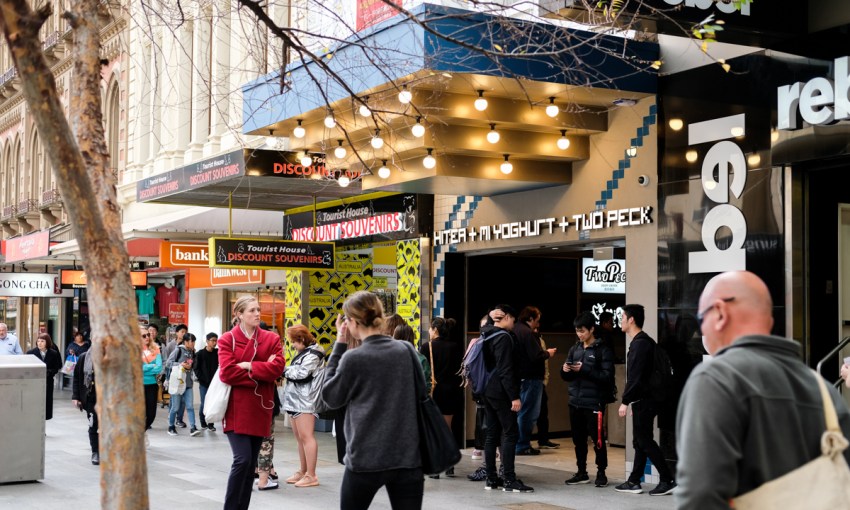From a surprise bumper winter month outperforming Mad March to the effects of football on North Adelaide, we parse bite-sized facts on the state of the city prepared by the Adelaide Economic Development Agency.
A statistical taste of the city’s economy
On Tuesday, CityMag attended Data4Lunch – the first of a series of Adelaide Economic Development Agency events aiming to impart easily digestible information about the city’s economy to South Australia’s movers-and-shakers.
Jaclyn Thorne, co-owner of market research agency McGregor Tan, gave a presentation within the Hilton Hotel conference room based on COVID data CityMag had already reported on.
But Jordon Tomopoulos, the Adelaide Economic Development Agency’s data analyst and number-cruncher, also guided the room through new economic tidbits, which he suggested the business owners in the room use to “plan, seize opportunities and thrive”.
—Jordon Tomopoulos
“Bear with us if we move pretty quickly but it’s for your benefit,” Jordon says from the lectern.
Statistical highlights included spikes in nighttime spend correlating with football matches, and people throwing down more dough in July than during Mad March.
Wearing a crisp grey suit, Jordon starts his “takeaway insights” with three of South Australia’s most important data points.
Our Gross State Product was “highest” in the 2020-21 financial year; the city’s population growth increased 13 per cent in 2021; and our residential vacancies were lowest in the nation, hovering at 1.7 per cent in July.
In March this year, InDaily reported information which contradicts that second data point. According to Australian Bureau of Statistics data, South Australia was back to losing people en masse, with the state’s population falling by 609 people in the September quarter to 1,772,800.
Moving to the next slide, Jordon shows data from September last year revealing the city’s office staff occupancy was the “best in [the] nation” in August, sitting at 71 per cent, and “our hotel occupancy has been consistently high”, hovering around 67 per cent in July.
Those living outside of the CBD and North Adelaide accounted for 95 per cent of the total city spend, and 34 per cent of the overall spend happened after 6pm. Surprisingly, nighttime city spend (between 6pm and 6am) was slightly higher in July ($122,606,221) compared to the same hours in March ($122,282,381).
“We actually have more spending in July’s nighttime economy than we did in March, which is our festival season,” Jordon says.
This might be a good omen for Illuminate Adelaide, the relatively new winter arts festival which runs the entire month of July, which seems to have helped the city outperform Mad March’s after-hours spend.

Will Illuminate Adelaide eclipse Mad March? (Illuminate Adelaide Unsound artwork by Rafal Dominik. This picture: Frankie the Creative)
Next slide, Jordon.
People are spending most of their city cash on dining and entertainment, which generated $161.32 million for the city economy for the month of July. Retail figures were much lower, flatlining at $77.61 million during the same period.
Sport also impacted the city’s bottom line, with one postcode 5000 locale getting more love than the others. “What’s really interesting is [the slides show] the impact of AFL matches and events and Adelaide Oval,” Jordon says.
“Almost a quarter of the spend on the days where there’s a match is in North Adelaide.”
Hanging over all of this 2021 data is the spectre of the pandemic. According to Jordon, “government mandates” impacted spending in the city, but he found “no correlation” between daily COVID cases and city spending and foot traffic.
“It wasn’t actually COVID and people being sick that impacted spending [but] it was government mandates, restrictions,” he says.

The Rundle Mall ‘Pigeon’. This picture: Johnny von Einem
Pedestrian counters show fewer people were in the city (only eight million in August), which is lower than levels recorded well before the COVID-19 pandemic began (11 million in July 2018). He later attributes this to “flexible working”.
Jordon also presented tourism insights, with data on air travel to Adelaide showing we’re seeing half the amount of flight passenger volumes compared to pre-COVID-19 levels. It’s also a lower amount than during the pandemic when Australians could only travel interstate. For example, South Australia welcomed 3630 air travel passengers this June compared to 5420 in June last year.
“We won’t shy away from our challenges,” Jordon tells the room.
Despite these hurdles, Adelaide is doing pretty well. We have “strong performance” relative to other cities, with a piping hot (our words) nighttime economy. Although we have fewer people moving through and working in the city, efforts are being made to draw people back in.
“It’s about us being strong promoters of Adelaide,” says Jordon, ever the optimist.




